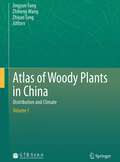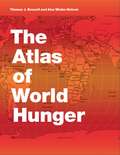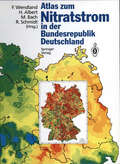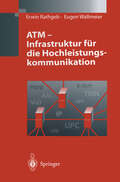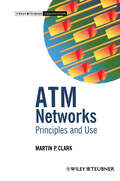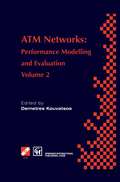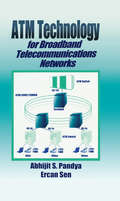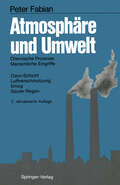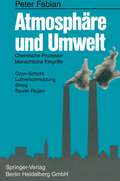- Table View
- List View
Atlas of Point Contact Spectra of Electron-Phonon Interactions in Metals
by A.V. Khotkevich Igor K. YansonThe characteristics of electrical contacts have long attracted the attention of researchers since these contacts are used in every electrical and electronic device. Earlier studies generally considered electrical contacts of large dimensions, having regions of current concentration with diameters substantially larger than the characteristic dimensions of the material: the interatomic distance, the mean free path for electrons, the coherence length in the superconducting state, etc. [110]. The development of microelectronics presented to scientists and engineers the task of studying the characteristics of electrical contacts with ultra-small dimensions. Characteristics of point contacts such as mechanical stability under continuous current loads, the magnitudes of electrical fluctuations, inherent sensitivity in radio devices and nonlinear characteristics in connection with electromagnetic radiation can not be understood and altered in the required way without knowledge of the physical processes occurring in contacts. Until recently it was thought that the electrical conductivity of contacts with direct conductance (without tunneling or semiconducting barriers) obeyed Ohm's law. Nonlinearities of the current-voltage characteristics were explained by joule heating of the metal in the region of the contact. However, studies of the current-voltage characteristics of metallic point contacts at low (liquid helium) temperatures [142] showed that heating effects were negligible in many cases and the nonlinear characteristics under these conditions were observed to take the form of the energy dependent probability of inelastic electron scattering, induced by various mechanisms.
Atlas of Remote Sensing for World Heritage: China
by Huadong GuoAtlas of Remote Sensing for World Heritage: China describes the UNESCO Natural and Cultural Heritage Sites in China and focuses on the interrelationship between culture and nature as well as on the breadth and complexity of China's world heritage sites. It emphasizes the application of space technology to world heritage, offering a vivid portrayal of China's forty world heritage sites and their surrounding environments by using multi-band, multi-resolution, multi-temporal spaceborne and airborne remote sensing data and 3D models. The book is a valuable resource for researchers in fields related to world heritage and to anyone with an appreciation of natural beauty and cultural landmarks. Professor Guo Huadong is the Director-General of the Center for Earth Observation and Digital Earth, the Chinese Academy of Sciences, China.
Atlas of Seeds and Fruits of Central and East-European Flora: The Carpathian Mountains Region
by Vít Bojnanský Agáta FargašováThe Atlas of Seeds and Fruits of Central and East-European Flora presents nearly 4,800 seed illustrations, supplemented with detailed seed descriptions, brief plant descriptions, and information on the locality and the native source of plants. The Carpathian flora covered here occurs not only in the Carpathian Mountains, but also in large lowlands extending towards the south, north and east and involves introduced and invading flora of more than 7,500 species. This publication is unique on two counts. Its scope extends to an unprecedented number of different plant seeds from a wide-ranging region. Moreover, it presents descriptions in unusual detail.
Atlas of Sexual Reproduction in Flowering Plants
by Mauro Cresti Stephen Blackmore Jacobus L. WentComprising about one hundred plates this atlas documents and describes the processes concerning the sexual reproduction in higher plants. It is dividedinto three parts: - Anther Development - Pistil Development - Progamic Phase and Fertilization. The scanning, transmission electron and light micrographs are all of immaculate quality and - for the viewer's orientation - almost each plate is complemented by a scheme showing a larger area of the plant indicating the site of the section. Together with instructive texts, the often striking images provide a valuable introduction into plant reproductive cell structures for researchers and advanced students of genetics, plantbreeding and cell biology.
Atlas of the Food System: Challenges for a Sustainable Transition of the Lisbon Region
by Teresa Marat-Mendes Sara Silva Lopes João Cunha Borges Patrícia Bento d'AlmeidaThis book is a visual guide to the territorial dynamics operating within a territory. The reading of such dynamics is fundamental in understanding the role of food in cities. This atlas provides a refreshing approach to the study of the city and of its territory, expanded from the perspective of the food system. This book illustrates the impacts of urban planning options on the function of the contemporary Food System of the Lisbon Region, while disclosing its associated urban form solutions. It provides a possible methodology for the reading of the food system based on an analysis of planning instruments and their morphological outcomes, both in the territory but also on the various built forms which have resulted over time. A key focus of the atlas is exploring how planning has regulated the evolution of the Lisbon Region since the 20th century and its implications on the food system. The atlas results from an exhaustive survey and research work conducted in Lisbon Metropolitan Area for a research project, SPLACH – Spatial Planning for Change, for the past 3 years, in terms of the analysis of its Food System and Urban Planning, aiming to inform the delineation of planning strategies towards a sustainable urban environment. It is an important reference for planners, architects, planning and architecture students as well as municipal technicians and the general public, as it provides a refreshing and useful source of information to support further readings about the food system and its relations to urban planning instruments and urban form solutions. Furthermore, it builds a contemporary reading about possible solutions to promote a sustainable transition of the current food systems, while enhancing the strategic role of planning and urban form.
Atlas of Woody Plants in China: Distribution and Climate
by Jingyun Fang Zhiheng Wang Zhiyao Tang"Atlas of Woody Plants in China: Distribution and Climate” documents the spatially-explicit county-level distribution of all 11,405 woody plants in China, together with life form information for most species. It also provides climate information for each species, with the county-level average and range of 12 climatic indices and of vegetation net primary productivity. It is the first and largest comprehensive atlas in the world for the distribution of China’s plants and was compiled on the basis of almost all related literature published throughout China. The atlas should serve as an indispensable handbook for all those who are interested in the plants, ecology, geography, environment, horticulture, and silviculture of China and East Asia. Dr. Jingyun Fang is a Cheung Kong Professor at the Department of Ecology, Peking University, China. Dr. Zhiheng Wang and Dr. Zhiyao Tang are both ecologists working at the same institute.
The Atlas of World Hunger
by Thomas J. Bassett Alex Winter-NelsonEarlier this year, President Obama declared one of his top priorities to be “making sure that people are able to get enough to eat.” The United States spends about five billion dollars on food aid and related programs each year, but still, both domestically and internationally, millions of people are hungry. In 2006, the Food and Agricultural Organization of the United Nations counted 850 million hungry people worldwide, but as food prices soared, an additional 100 million or more who were vulnerable succumbed to food insecurity. If hunger were simply a matter of food production, no one would go without. There is more than enough food produced annually to provide every living person with a healthy diet, yet so many suffer from food shortages, unsafe water, and malnutrition every year. That’s because hunger is a complex political, economic, and ecological phenomenon. The interplay of these forces produces a geography of hunger that Thomas J. Bassett and Alex Winter-Nelson illuminate in this empowering book. The Atlas of World Hunger uses a conceptual framework informed by geography and agricultural economics to present a hunger index that combines food availability, household access, and nutritional outcomes into a single tool—one that delivers a fuller understanding of the scope of global hunger, its underlying mechanisms, and the ways in which the goals for ending hunger can be achieved. The first depiction of the geography of hunger worldwide, the Atlas will be an important resource for teachers, students, and anyone else interested in understanding the geography and causes of hunger. This knowledge, the authors argue, is a critical first step toward eliminating unnecessary suffering in a world of plenty.
The Atlas of World Hunger
by Thomas J. Bassett Alex Winter-NelsonEarlier this year, President Obama declared one of his top priorities to be “making sure that people are able to get enough to eat.” The United States spends about five billion dollars on food aid and related programs each year, but still, both domestically and internationally, millions of people are hungry. In 2006, the Food and Agricultural Organization of the United Nations counted 850 million hungry people worldwide, but as food prices soared, an additional 100 million or more who were vulnerable succumbed to food insecurity. If hunger were simply a matter of food production, no one would go without. There is more than enough food produced annually to provide every living person with a healthy diet, yet so many suffer from food shortages, unsafe water, and malnutrition every year. That’s because hunger is a complex political, economic, and ecological phenomenon. The interplay of these forces produces a geography of hunger that Thomas J. Bassett and Alex Winter-Nelson illuminate in this empowering book. The Atlas of World Hunger uses a conceptual framework informed by geography and agricultural economics to present a hunger index that combines food availability, household access, and nutritional outcomes into a single tool—one that delivers a fuller understanding of the scope of global hunger, its underlying mechanisms, and the ways in which the goals for ending hunger can be achieved. The first depiction of the geography of hunger worldwide, the Atlas will be an important resource for teachers, students, and anyone else interested in understanding the geography and causes of hunger. This knowledge, the authors argue, is a critical first step toward eliminating unnecessary suffering in a world of plenty.
Atlas zum Nitratstrom in der Bundesrepublik Deutschland: Rasterkarten zu geowissenschaftlichen Grundlagen, Stickstoffbilanzgrößen und Modellergebnissen
by R. Becker S. Biermann K. Großmann I. Hiller K. J. Hülsbergen R. Michel A. Schumacher U. SturmATM - Infrastruktur für die Hochleistungskommunikation
by Erwin Rathgeb Eugen WallmeierDie Autoren stellen die technischen Aspekte vom ATM gemäß ihrer Relevanz für Entwickler und Entscheidungsträger dar. Das Auflisten von Standards wird auf das Nötigste eingeschränkt, das Hauptaugenmerk liegt auf grundsätzlichen, langfristig gültigen Aussagen zu Funktionen und Mechanismen.
ATM Network Performance (The Springer International Series in Engineering and Computer Science #537)
by George KesidisATM Network Performance, Second Edition, describes approaches to computer and communication network management at the ATM layer of the protocol hierarchy. The focus is on satisfying quality-of-service requirements for individual connections. Results in both areas of bandwidth scheduling and traffic control are explained. Recent results in end-to-end performance, provisioning for video connections and statistical multiplexing are also described. All of the material has been updated where appropriate and new references added and expanded. Timely updates: Entirely new chapter on ATM switches with an emphasis on scalable-to-terabit switching. New material on round-robin scheduling, jitter control, QoS paradigms as well as special treatment of fluid modeling and variable bit rate channel capacity. Expanded coverage of CBR channels, IP over ATM, and guaranteed-rate performance. Substantial increase in end-of-chapter exercises. Solutions for selected exercises in separate appendix. Complete solutions for all exercises also available from author.
ATM Networks: Principles and Use
by Martin P. ClarkThe modern telecommunications world is a complicated place, overloaded with jargon and bewilderingly full of different technical options and opportunities. Many experts are only experts of small domains and within limited geographies. For newcomers it is often difficult to gain a grasp on the basic principles and even harder to unravel the mysterious technical paradoxes and the apparent contradictions of many modern technologies. My greatest hope in writing this book is that you, the reader, will find help and insight amongst its pages. I wish for no greater commendation than your thoughts that you find the subject of A TM presented here in an accessible and readable form. I hope also that the comprehensive glossary will remain with you, as your wayfinder through all that jargon! Martin P. Clark Frankfurt, Germany 20 December 1995 Acknowledgements No book on Asynchronous Transfer Mode (ATM) could fail to recognize the invaluable contribution to this technology and to world standardization as a whole made by the International Telecommunications Union and the ATM Forum, and you will find references to their work throughout the text. Particular copyright extracts are labelled accordingly, but the full texts may be obtained (as relevant) from ITU Sales and Marketing Service, Place des Nations, CH-1211 Geneva 20, Switzerland or from ATM Forum, 2570 West EI Camino Real, Suite 304, Mountain View, California CA 94040, USA.
ATM Networks: Performance Modelling and Evaluation (IFIP Advances in Information and Communication Technology)
by Demetres D. KouvatsosUnlike many books on Asynchronous Transfer Mode, this text approaches the subject systematically and reflects the state-of-the-art technology being applied throughout the world today. In addition, it provides a fundamental source of reference in the ATM research field. The following topics are discussed in detail: * traffic modelling and characterisation * traffic and congestion control * bandwidth and admission control * ATM switch architecture * models of ATM switches * routing and optimisation * quality of service * network management * high speed LANs and MANs * performance modelling studies
ATM Networks: Performance Modelling and Evaluation (IFIP Advances in Information and Communication Technology)
by Demetres D. KouvatsosThis book presents a selection of expanded research papers from the Fourth IFIP Workshop on the Performance Modelling and Evaluation of ATM Networks. It provides a fundamental source of reference on the latest research techniques and tools concerning ATM networks worldwide. A number of important topics are featured including: traffic modelling and characterisation, models of ATM switches, network management, high speed LANs and MANs and routing and optimization.
ATM Technology for Broadband Telecommunications Networks
by Ercan SenThis textbook presents all the latest information on all aspects of each important component of ATM - the hottest telecommunications technology of this decade. It demonstrates how ATM internetworks several incompatible telecommunications technologies and provide the high-speed, high bandwidth backbone network that the entire telecom industry is converging toward.
ATM Technology for Broadband Telecommunications Networks
by Ercan SenThis textbook presents all the latest information on all aspects of each important component of ATM - the hottest telecommunications technology of this decade. It demonstrates how ATM internetworks several incompatible telecommunications technologies and provide the high-speed, high bandwidth backbone network that the entire telecom industry is converging toward.
Atmel AVR Microcontroller Primer: Programming and Interfacing (Synthesis Lectures on Digital Circuits & Systems)
by Steven F. Barrett Daniel J. PackThis textbook provides practicing scientists and engineers a primer on the Atmel AVR microcontroller. Our approach is to provide the fundamental skills to quickly get up and operating with this internationally popular microcontroller. The Atmel ATmega16 is used as a representative sample of the AVR line. The knowledge you gain on the ATmega16 can be easily translated to every other microcontroller in the AVR line. We cover the main subsystems aboard the ATmega16, providing a short theory section followed by a description of the related microcontroller subsystem with accompanying hardware and software to exercise the subsytem. In all examples, we use the C programming language. We conclude with a detailed chapter describing how to interface the microcontroller to a wide variety of input and output devices. Table of Contents: Atmel AVR Architecture Overview / Serial Communication Subsystem / Analog-to-Digital Conversion / Interrupt Subsystem / Timing Subsystem / Atmel AVR Operating Parameters and Interfacing / ATmega16 Register Set / ATmega16 Header File
Atmel AVR Microcontroller Primer: Programming and Interfacing, Second Edition (Synthesis Lectures on Digital Circuits & Systems)
by Steven Barrett Daniel PackThis textbook provides practicing scientists and engineers a primer on the Atmel AVR microcontroller. In this second edition we highlight the popular ATmega164 microcontroller and other pin-for-pin controllers in the family with a complement of flash memory up to 128 kbytes. The second edition also adds a chapter on embedded system design fundamentals and provides extended examples on two different autonomous robots. Our approach is to provide the fundamental skills to quickly get up and operating with this internationally popular microcontroller. We cover the main subsystems aboard the ATmega164, providing a short theory section followed by a description of the related microcontroller subsystem with accompanying hardware and software to exercise the subsystem. In all examples, we use the C programming language. We include a detailed chapter describing how to interface the microcontroller to a wide variety of input and output devices and conclude with several system level examples. Table of Contents: Atmel AVR Architecture Overview / Serial Communication Subsystem / Analog-to-Digital Conversion / Interrupt Subsystem / Timing Subsystem / Atmel AVR Operating Parameters and Interfacing / Embedded Systems Design
Atmende Städte: Zukunftschancen für Stadt und Land mit und nach Corona
by Christa Reicher Jürgen TietzDie dramatische Sars-CoV-2 Pandemie wirkt weltweit in vielen Bereichen des Lebens wie ein Brandbeschleuniger. Davon sind auch Architektur und Städtebau betroffen. Der Handel in den Innenstädten ist weggebrochen, die Bedeutung von Büros nimmt ab. Dafür werden mehr Grünflächen für die Erholung benötigt und veränderte Wohnungsgrundrisse, um das Homeoffice aufzunehmen. Das Buch benennt die wichtigsten architektonischen und städtebaulichen Veränderungen, die mit Corona in Stadt und Land einhergehen, stellt sie in den Kontext des Stadtumbaus durch den Klimawandel, verortet sie historisch und leitet daraus konkrete Strategien und Chancen ab, um den zentralen Zukunftsherausforderungen zu begegnen, die sich aus der Pandemie für Stadt und Land ergeben.
Atmosphäre und Umwelt: Chemische Prozesse · Menschliche Eingriffe Ozon-Schicht · Luftverschmutzung Smog · Saurer Regen
by Peter FabianAtmosphäre und Umwelt: Chemische Prozesse - Menschliche Eingriffe - Ozon-Schicht - Luftverschmutzung Smog - Saurer Regen
by Peter FabianUnsere Atmosphäre, das Luftmeer, auf dessen Grunde wir leben, ist ein Gasgemisch, das neben den Hauptbestandteilen Stickstoff und Sauerstoff eine Vielzahl von Spurengasen enthält. Dieses Gasgemisch an sich wäre reaktionsträge und somit von geringem chemischen Interesse, würde es nicht im Wechsel von Tag und Nacht und im Rhythmus der Jahreszeiten von der Sonne bestrahlt. Die Sonnenstrahlung, insbesondere ihr energie reicher Ultraviolettanteil, vermag die meisten Konstituenten des atmo sphärischen Gasgemisches in ihre Bestandteile zu spalten. Durch diesen photochemischen Prozeß, den man als "Photolyse" oder "Photodissozia tion" bezeichnet, entstehen äußerst reaktive Substanzen, die für uns Erdbewohner wichtige chemische Reaktionsketten auslösen. Lediglich die atmosphärischen Edelgase, Argon, Neon, Helium und Krypton (in der Reihenfolge ihrer Häufigkeit) nehmen an diesen Prozessen nicht teil. Der wohl wichtigste photochemische Prozeß in unserer Atmosphäre ist die Bildung von Ozon (s. Abschnitt 2). Ozon ist die dreiatomige Form des Luftsauerstoffs, 0 • Der normale Sauerstoff besteht aus O , zwei mit 3 2 einander verbundenen Sauerstoff-Atomen. Unter Einwirkung der Ultra violettstrahlung der Sonne wird ein Teil des Luftsauerstoffs O gespalten, 2 und die gebildeten Sauerstoffatome können sich mit zweiatomigen Sauer stoffmolekülen zum dreiatomigen Ozon verbinden. Die hieraus resultie rende atmosphärische Ozonschicht ist für uns in zweifacher Hinsicht von großer Bedeutung. Zum einen schirmt sie die gefährliche Ultraviolett strahlung der Sonne ab, welche ohne diesen Filter alles Leben auf dem Festland auslöschen würde. Zum anderen bewirkt die Energie dieser in der Höhe absorbierten Strahlung dort eine beachtliche Erwärmung, sie hat damit Einfluß auf die allgemeine Luftzirkulation.
Atmosphäre und Umwelt: Chemische Prozesse, Menschliche Eingriffe. Ozon-Schicht, Luftverschmutzung, Smog, Saurer Regen
by Peter FabianAtmosphärische Ausbreitungsmodellierung: Grundlagen und Praxis
by Axel ZengerAtmosphärische Ausbreitungsmodellierungen werden heute nicht mehr ausschließlich von Meteorologen durchgeführt. Viele Stadt- oder Verkehrsplaner, Bauingenieure und Architekten setzen mittlerweile Ausbreitungsmodelle ein, um mögliche lufthygienische Auswirkungen ihrer Planungen schon im Vorfeld abschätzen zu können. Die Anwender verfügen aber oft nicht über das notwendige methodische und meteorologische Basiswissen. Dieses Wissen ist jedoch unabdingbar, um die verschiedenen Modellierungsansätze besser verstehen bzw. deren Einsatzmöglichkeiten und Zuverlässigkeit einschätzen zu können. Der Autor beschreibt anschaulich und mit einem Minimum an Formeln die physikalischen, meteorologischen und numerischen Grundlagen. An Beispielen wird gezeigt, wie Ausbreitungsrechnungen und Emmissionsprognosen durchzuführen sind. Die mitgelieferten Programme ermöglichen dabei die unmittelbare Umsetzung der dargestellten Sachverhalte.





